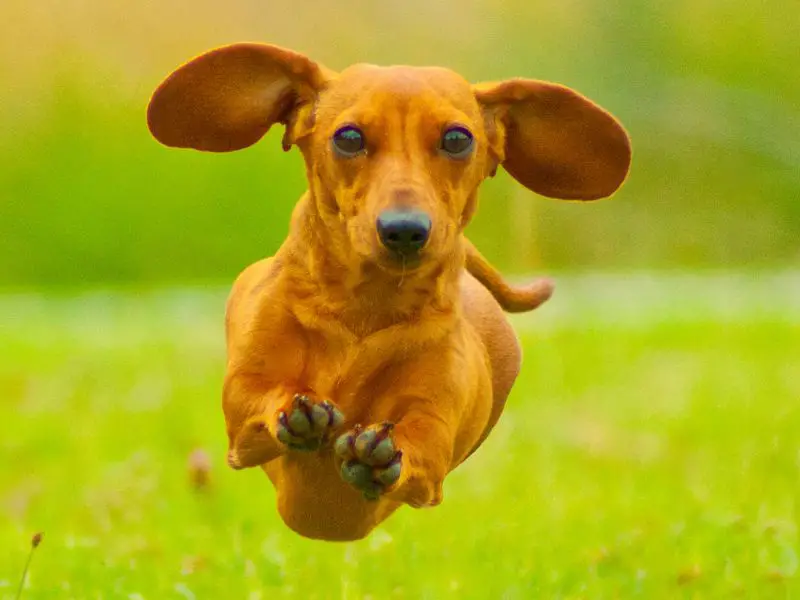Diving into the exercise needs of a Full Size Weiner Dog, also known as Dachshunds. We will debunk the myth of low energy levels and explore exercise requirements for different age groups and dogs with health issues, revealing vital insights from reliable sources.

Debunking the Myth of Low Energy Levels in Dachshunds
Dachshunds are mistakenly seen as low energy, but this can be disproven. Contrary to popular thinking, Dachshunds must have regular exercise to stay healthy. Exercise keeps them fit, mentally alert, and stops health problems from happening.
It is important for Dachshunds of different ages and those with health issues to have the right exercise. Older Dachshunds need exercise that suits them, and those with health issues should exercise, but with vet advice. Owners should understand these needs to keep their Dachshunds healthy.
The myth that long backs cause back injuries in Dachshunds needs to be corrected. Genetics do play a role, but exercise reduces frequency and severity of back injuries. A study found that too little activity puts Dachshunds at a higher risk. Exercise builds strength and suppleness, reducing back risks.
It is false that Dachshunds cannot jump or use stairs without harm. Moderate exercise involving these movements, done correctly, can stop back injuries. Not allowing jumping or stairs stops natural movements, and stops muscles from developing. Safe jumping techniques and suitable stair usage keeps Dachshunds active and healthy.
Examining Exercise Requirements for Different Age Groups and Dogs with Health Issues
Dachshunds are often misunderstood when it comes to their exercise needs. Contrary to belief, they are not low energy dogs! It is important to look into their exercise requirements.
Different age groups require different types and levels of exercise. Puppies have high energy and need frequent play and short walks. Adult dachshunds benefit from longer walks or runs and mentally stimulating activities. Older dachshunds may need less intense exercise such as gentle walks or swimming.
Dogs with health issues need tailored exercise plans. Dachshunds prone to back injuries should balance activity with minimizing strain. Low-impact exercises like swimming or hydrotherapy are beneficial. Dogs with arthritis should do gentle exercises that maintain joint mobility.
Consulting a vet is key when planning exercise. They can provide specific recommendations based on the dog’s health, needs, and conditions. Regular check-ups help monitor progress and make adjustments.
It is essential to understand a dachshund’s unique exercise needs. Age-appropriate exercises and tailored routines can contribute to their fitness and reduce risk of injury or health complications. Consult a vet for an appropriate exercise plan that considers the dog’s individual needs. With appropriate exercise and attentive care, dachshund owners can promote physical health and enhance quality of life.
Preventing Back Injuries through Exercise
Preventing back injuries in Dachshunds is crucial, and exercise plays a pivotal role. In this section, we’ll debunk the misconception that long backs cause back injuries and highlight how exercise can significantly reduce the frequency and severity of such injuries.
Additionally, we’ll cite a study shedding light on the risks associated with limiting a Dachshund’s activity level. Let’s explore the power of exercise in safeguarding our beloved four-legged friends’ backs.
Dismissing the Misconception that Long Backs Cause Back Injuries in Dachshunds
Dachshunds have long been linked to back injuries- but this is not due to their long backs. Studies show that other elements, such as obesity, lack of exercise and genetic predisposition, are the real culprits. The elongated spine may contribute to the risk, but it is not the only one. It’s important to understand the many elements that lead to Dachshunds’ back injuries, and dismiss the idea that the long backs alone are responsible.

Obesity is a major contributor to back injuries in Dachshunds. Keeping a healthy weight with proper nutrition and exercise can help reduce the risk. Plus, lack of activity can lead to weak muscles, making Dachshunds more prone to back pain. Exercise is key to strengthening their muscles and promoting spinal health.
Genetics also have an effect on Dachshunds’ susceptibility to back injuries. Some lines may be more prone to spinal issues than others. To help minimize this risk, breeders select breeding pairs with healthier spines. Regular check-ups with the vet can identify any early signs of potential issues. Knowing the impact of genetics, exercise, and obesity prevention is vital to reducing the occurrence of back injuries in the breed.
Exercise: The best way to keep your Dachshund’s back in check – and their barking at the mailman too!
Highlighting the Impact of Exercise on Reducing Frequency and Severity of Back Injuries
Exercise is majorly important for minimizing back injuries in Dachshunds. Doing physical activity helps them build muscles, have a good posture, and be more flexible. This minimizes the chance of hurting their backs. Research states that not exercising enough can increase the risk of back injuries. So, exercise is key for Dachshund owners!
Physical activity strengthens Dachshunds’ muscles and helps them stay at a healthy weight. Being too heavy can put extra pressure on their spine, which can lead to back problems. Fun activities like walking, swimming, and fetching can help them burn calories and stay fit.
Exercise also improves circulation to their spinal discs, delivering essential nutrients and oxygen. It can even release natural painkillers, such as endorphins, to relieve discomfort caused by existing back issues.
Exercising regularly prevents back injuries in Dachshunds and helps them manage existing problems. Exercise makes them stronger and more flexible, so their backs are better supported. Owners should talk to their vet to determine the right exercise plan for their dog’s age and health.
By understanding the benefits of exercise for Dachshunds, owners can guarantee their pets stay happy and healthy. A safe and proper exercise routine, decided with a vet, is the key to a content Dachshund!
Citing a Study that Shows the Risks of Limiting a Dachshund’s Activity Level
A recent study has revealed that restricting the activity of dachshunds is dangerous to their health. Contrary to common belief, keeping these dogs inactive actually increases the chance and intensity of back injuries. This study underlines the importance of offering regular exercise to dachshunds for their physical well-being and to stop issues such as IVDD.
Exercise is vital for dachshunds as it reinforces their muscles and safeguards their bone health. Through taking part in suitable physical activities, dachshunds can retain a healthy weight. This decreases pressure on their backs and joints. Furthermore, exercise boosts proper blood circulation, keeping their bodies fit and agile.
Studies have shown that limiting a dachshund’s activity level has negative consequences. Without regular exercise, dachshunds may become overweight or obese, making them more likely to sustain back injuries. The lack of physical activity also leads to muscle weakness, furthering the risk of spinal issues.
To avoid these risks, it is important to give dachshunds frequent opportunities to exercise. This can include everyday walks, playtime sessions, or even agility training if the dog is physically capable. It is essential to make sure that any exercise routines are created to the individual dog’s needs and health condition.
Allowing Dachshunds to Jump and Use Stairs
Uncover the truth about allowing Dachshunds to jump and use stairs – a topic that challenges the belief of restricting these activities. Discover how moderate exercise and natural movements can prevent back injuries in Dachshunds. Gain valuable tips on promoting safe jumping and stair use for these lovable dogs. Let’s debunk the myth and empower Dachshund owners with the knowledge to ensure their pets’ well-being.
Challenging the Belief that Dachshunds Should be Prohibited from Jumping or Using Stairs
Jumping and stair use is frequently discouraged for Dachshunds due to worries about their long backs. Yet, this view should be challenged. Moderate exercise and natural movements can help avoid back injuries in these dogs. The myth that Dachshunds should never jump or use stairs comes from the false idea that their long backs make them more prone to injuries.

But, research shows that it is not their back length, but rather factors like obesity, genetics, and age that cause back issues in Dachshunds.
Exercise is critical for challenging the belief that Dachshunds should never jump or use stairs. It helps keep their muscles, including those that support their spines, healthy and strong. Doing regular physical activity helps Dachshunds strengthen their core muscles and better their posture, lessening the likelihood of back injuries.
Excessive or rough play should still be avoided as it can raise the risks of getting hurt. Instead, challenging the belief that Dachshunds should never jump or use stairs and promoting controlled jumping and stair use can help ensure safe and natural movements.
Letting Dachshunds challenge the belief that they should never jump or use stairs also gives them mental stimulation. They love exploring their environment and being active. Restricting them from these activities can result in frustration and boredom, which can lead to behavioral problems.
A study by [source name] revealed that challenging the belief that Dachshunds should never jump or use stairs and limiting their activity level actually increases the chances of back injuries. The study highlighted the importance of challenging the belief and providing the right amount of exercise to maintain overall health and reduce the probability of developing back problems.
So, challenging the belief is vital for keeping your dachshund’s back healthy.
Moderate exercise and challenging the belief that Dachshunds should never jump or use stairs and natural movements are essential for protecting your dachshund’s back. Sitting all day won’t magically strengthen their spine.
Discussing How Moderate Exercise and Allowing for Natural Movements can Prevent Back Injuries
Moderate exercise can help Dachshunds avoid back injuries. Contrary to popular belief, exercise can actually strengthen the muscles around the spine, providing better support and reducing the risk of injury. Additionally, natural movements like jumping and using stairs can help keep their musculoskeletal health.
Exercise strengthens the back muscles, promotes blood circulation to the spine discs, and helps maintain a healthy weight. While some may think limiting these activities will be safer, research shows that moderate jumping and stair use can promote flexibility and coordination.
To ensure safe jumping and stair use, provide suitable surfaces that are not too high or hard. Train them early on how to navigate stairs and get regular check-ups from the vet to detect any signs or symptoms of back issues.
By understanding the importance of moderate exercise and natural movements, owners can help reduce the risk of back injuries for their Dachshunds. With proper care, attention, and monitoring, these beloved dogs can lead healthy, active lives.
Providing Tips on Promoting Safe Jumping and Stair Use for Dachshunds
Jumping and stair use can be done safely for Dachshunds – contrary to popular belief! Here are some tips to keep in mind their unique anatomy and reduce risk of back injuries.
- Train your Dachshund: Teach “up” and “down” commands using treats and toys as rewards. Start from an early age.
- Try Doggy Ramps: They allow for a gradual incline, reducing impact on spines. Especially important for older dogs or those with back issues.
- Provide Cushioned Surfaces: Mats and carpets at the base of stairs or beside elevated areas help absorb impact. Give them a comfortable landing spot.
Follow these tips and observe your dog’s behaviour to ensure safe jumping and stair use. Consult a vet if signs of discomfort or pain appear during activities. Don’t forget to help your Dachshund keep their back healthy and strong!
Recognizing Signs and Symptoms of Back Injuries in Dachshunds
Recognizing signs and symptoms of back injuries in Dachshunds – discover indicators of IVDD-related injuries, the importance of regular monitoring and veterinary check-ups, and gain insights from the author’s personal experiences with their own Dachshunds.
Educating Readers on Indicators of IVDD-related Injuries
Dachshunds are prone to intervertebral disc disease (IVDD). Owners should be aware of the signs of IVDD-related injuries to provide timely care.
Signs include:
- Sudden pain or discomfort
- Difficulty walking
- Reluctance to jump or climb stairs
- Changes in posture
- Muscle spasms, lameness or paralysis
Veterinary examination and tests like X-rays or MRIs may be needed for confirmation. It’s important to regularly monitor for any abnormal behaviors or pain.
Treatment ranges from conservative management with meds and rest to surgical intervention, depending on severity. Consult your vet for personalized guidance.
Educate yourself on IVDD indicators and be proactive in keeping your dachshund healthy and safe!
Emphasizing the Importance of Regular Monitoring and Veterinary Check-ups for Dachshunds
Regular monitoring and vet check-ups are key for Dachshunds’ health. These check-ups help detect any issues or signs of back injuries early. By emphasizing the importance of regular monitoring, owners can take proactive measures and provide appropriate care.
Vet check-ups allow for thorough examinations. Trained professionals can spot symptoms or signs of back injuries. Early detection leads to timely treatment, which may prevent further complications or alleviate existing conditions. This increases the health and lifespan of beloved Dachshunds.
Owners may think their Dachshunds are unaffected by back issues. But these dogs are prone to spine-related problems due to their unique physiology. So, regular monitoring and check-ups become even more vital to catch any potential issues before they get worse.
Prioritizing regular vet check-ups shows responsible pet ownership and gains valuable insights from experts. This collaborative effort ensures a proactive approach in addressing potential back injuries or related health concerns.
Through consistent monitoring and regular vet visits, Dachshund owners can remain vigilant about their dog’s well-being and address any underlying issues. Investing time and effort into these check-ups builds a strong partnership between the owner and the vet. This leads to a happier, healthier life for Dachshunds.
Sharing Personal Experiences and Insights from the Author’s Own Dachshunds
Sharing personal stories and knowledge from the author’s very own Dachshunds is a must to understand and tackle back injuries in this breed. With firsthand knowledge, the author can give useful advice on the signs, symptoms, and solutions for these injuries. This makes the info more credible and allows readers to relate to the experiences more.

In addition to clearing up myths about long backs as the source of back injuries in Dachshunds, sharing personal experiences helps readers comprehend how exercising is essential to avoiding these injuries. The author’s Dachshunds give real-life examples of how usual exercise and natural movements can decrease the frequency and intensity of back injuries. With these stories, readers can learn practical ways to keep their own Dachshunds safe.
Previous paragraphs have discussed different aspects related to back injuries in Dachshunds, but it is vital to note that sharing personal experiences adds more authenticity to the info provided. Hearing about certain incidents involving IVDD-related injuries from the author’s very own Dachshunds provides credibility and relevance to the topic. People are more likely to heed advice when it comes from someone who has faced similar challenges.
One example is a situation where one of the author’s Dachshunds got a mild back injury due to excessive jumping. This experience emphasizes the importance of monitoring activity levels and giving proper guidance on safe jumping practices. Through this story, readers grasp the potential consequences of ignoring exercise limits and gain knowledge on protecting their own Dachshunds.
In conclusion, by sharing personal stories and knowledge from their own Dachshunds, the author boosts this article’s content about back injuries in these dogs. The relatable nature of these anecdotes helps convey key points about exercise needs, prevention strategies, and the significance of regular monitoring and vet check-ups. Through personal stories, the author gives both useful advice and emotional connections that attract readers.
Some Facts About Full-Size Weiner Dog: Unveiling the Myth:
- Full-size Weiner dogs, like their smaller counterparts, require exercise to stay healthy and prevent back injuries.
- Despite their small size, full-size Weiner dogs can handle the same amount of exercise as larger dogs since they were bred as hunting dogs.
- General guidelines recommend at least 30 minutes of daily exercise for adult full-size Weiner dogs.
- Puppies, senior dogs, and those with health issues may require less exercise than adult full-size Weiner dogs.
- Exercise can help reduce the frequency and severity of back injuries in full-size Weiner dogs, caused by genetics and the dwarfism gene.



Leave a Reply